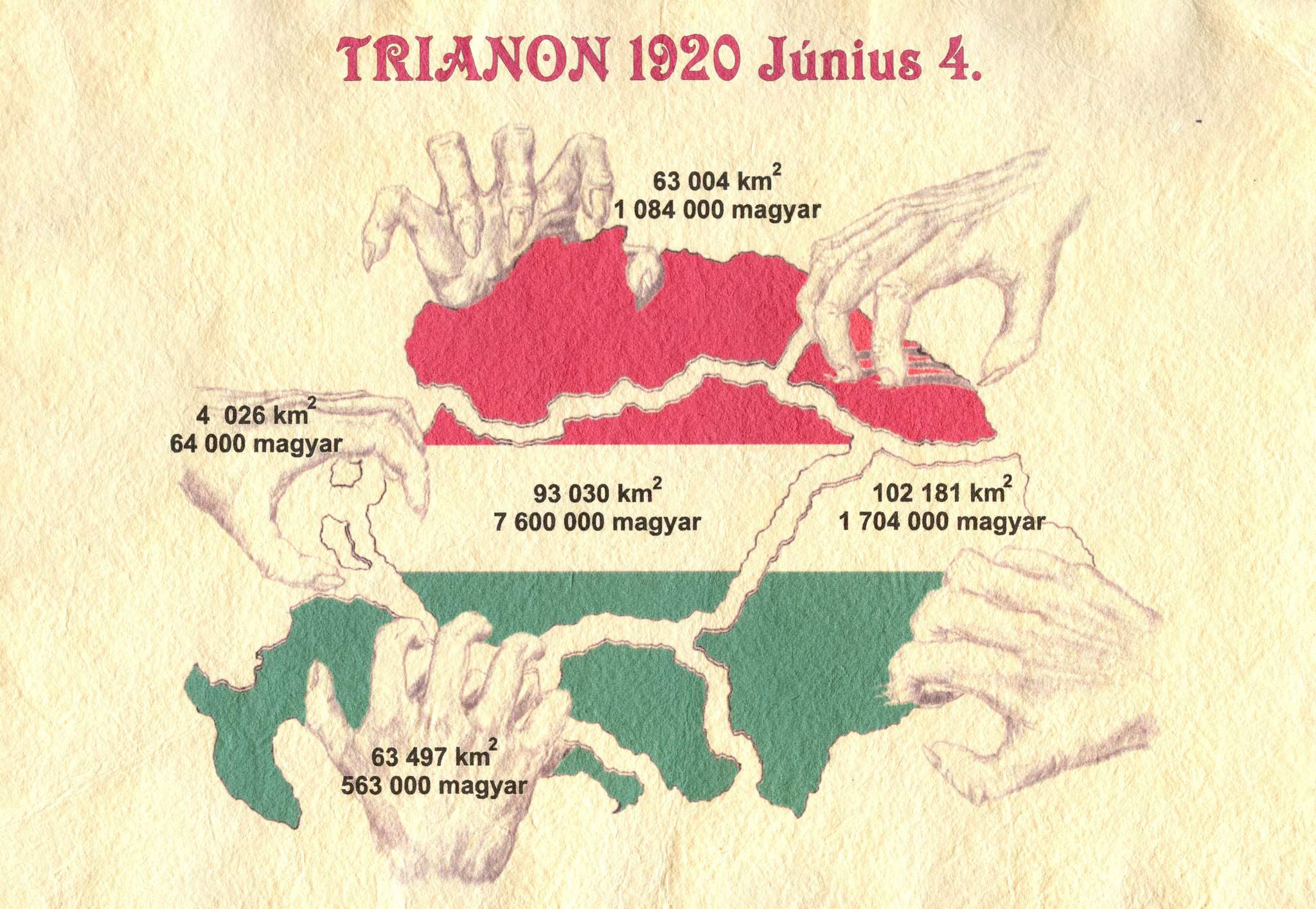Trianon: It was realistic 100 years ago that Hungary disappears from the maps
Balázs Ablonczy, leader of the Trianon 100 research team, told that in the autumn of 1919 there was a real chance that Hungary disappears because the neighbours divide it among themselves. It would not have been without a parallel in the region because the same happened to Poland at the end of the 18th century.
Balázs Ablonczy said to index.hu in an interview that the Hungarian society was yet unable to process the question of Trianon and there are many conspiracy theories linked to the issue in people’s mind (HERE you can read about some of them). He says that people feel it rightfully that the peace treaty did something very unjust to the Hungarians, which is impossible to forget and hard to understand.
- Trianon peace treaty 100: was there a chance to preserve Greater Hungary?
- Hungarian minority insulted – Romania to establish Day of the Peace Treaty of Trianon?
- When will Hungary get back its lost territories? – Trianon is 99 yrs old
In short, Hungary lost 2/3rd of its territories because of the peace treaty and more than 3 million Hungarians were forced to become citizens of the neighbouring countries who behaved and still are behaving hostile towards them. This is the core of the problem. The main task of the Trianon 100 research group lead by Ablonczy is to measure the events between 1918-1920 from different perspectives and provide answers on the frustrating “How could that happen?” question. This is important because the answers to this question and
the whole issue polarise the Hungarian society even today
and it has an understandable impact on bilateral ties and regional stability, as well.
Mr Ablonczy says that Trianon became the metaphor for all the catastrophes we experience in our lives. One starts to speak about the peace treaty but continues with criticising the names parents give their children and concludes that his wife divorced him and took the house.
During the communist Kádár-regime, the issue was considered as a taboo. Today, even though 2-3 million people in Hungary have ancestors coming from the Hungarian communities living abroad, Hungarians still were not able to speak about the issue freely. Therefore,
more people get their information about Trianon from conspiracy theories spreading on YouTube than from Historians.
But why did Hungary receive such a harsh peace? Balázs Ablonczy, Ádám Kolozsi and András Zsuppán (all Historians) agreed in a podcast of index.hu that when the great powers decided to divide the Austro-Hungarian Monarchy, they said that only the core territories populated by the Hungarian people could belong to future Hungary. Therefore, there was no chance to keep, for example, the Szeklerland where 700 thousand Hungarians live in a block in the heart of today’s Romania.
The central territories populated mostly by Hungarian nationals were much bigger than today’s Hungary. However, in that case, other factors decided. In the North, those were the geographical position of the rivers (Danube, Ipoly) while in the East that was the railroads because of what 98 pc Hungarian cities like Nagyvárad (Oradea, Romania) were lost.
The three Historians agreed that Hungarians were alienated in contemporary Europe and, in contrast to their positive assessment in 1848 (people of freedom),
they were viewed as the people of oppression by 1918.
They said that the whole Hungarian elite is responsible for what happened and that the 133 days long communist rule between March and August of 1919 did not strengthen the positions of Hungary during the peace talks in Paris. Indeed, the country was not even invited there.
Talking about today’s problems, Ablonczy said that many Hungarians reject the national belonging with those who live beyond the borders. Some of them say that
Hungarians from Transylvania “are like Romanians.”
Finally, what good – if any – did Trianon?
Almost nothing. It was realistic in the autumn of 1919 that Hungary disappears from the maps. 2/3rd of the country was occupied while the economic collapse seemed almost impossible to survive.
Source: index.hu
please make a donation here
Hot news
What happened today in Hungary – 26 July, 2024
Drama: number of births in a 20-year low in Hungary
Yay or nay? – 6 odd Hungarian delicacies that make our skin crawl
Budapest tourism “exploded” this past weekend
Container transport in Budapest may stop: How will this affect Hungarian economy?
Minister: Hungary will protect its territory by every means possible





6 Comments
Trianon might correct between statesmen. Its unfair for all the Hungarian people tahat effect its. This people were not players in this war. Now a days its hard to correct the 1919 desicion, but they have to respect the Hubgatian people in the despora.
Trianon is about a mad rush to the cooky
Jar by gready English French and American who used the land grab to satisfy there hunger for depopulating Hungary of extremely intelligent, talented, and good looking race of people, as Russia as in all wars was used by the British and Americans to do there dirty workand then regarded as the enemy.
If Hungary (Austro Habsburgs) had not started WW1 because of a petty beef with Serbia, there would not have been a need for Trianon.
Just say NO! to Roumania!
The Geo-political theft of more than a third of a great kingdom, no thinks to Europe,
UK, and USA took place by a treaty called Trianon, 4 June 1919. 🙁 🙁 🙁
Part of that treaty took what is known as Transylvania from Hungary which was ceded to
Roumania, a poor nation then and a poor nation now.
Transylvania is the land of many of my Magyare ancestros, including my grandparents
and great grandparents who had owned land in this place that the west only knows for the
horror tales of Dracula and Vlad the Impaler, and a Countess Erszébet Báthory who was
starved to death and given a horrid macabre myth from which the expression blood bath
was eventually coined.
It is quite possible that I am directly descended from the Countess. But whether I am or not,
Transylvania in part belongs to me, as it belongs to others who are descended from forbearers
of this place, including everyone’s favorite Dracula, Béla Lugosi, or a man named Cukor or
a trio of sisters named Gabor and a guy named Puskás. When our families emigrated, others
did not. It was they who protected holdings that belonged to them and who protect it now.
Roumania has named a holiday on 4 June to celebrate thier ill-gotten gains. If you love your
freedom and the right to your own heritage, identity, and culture, wear BLACK on that day
for the Magyars and their land to be returned to them in solidarity of FREEDOM from tyranny.
The Habsburgs stabbed Hungarians in the back again. Negotiated Transylvania from Hungary.
You are totally right! I was born in Transylvania, Hungarian nationality. Grew up there in the communism. They heat us in Romania, calls us bozgor(people without land). After communism we moved to Hungary. They heat us there as well called us romanian gipsy. We were not accepted. My grandfather was in the Hungarian army both 1st and 2nd war.
Lately I see comments here how delicious is romanian food, like kurtos kalacs, toltott kaposzta, langos etc. Those are all Hungarian foods. Now Romanians are taking credit. Shame on all those people. My other grandfather is buried in Uzvolgy. The year when the trianon turned 100 years romanian people went to that cemetery and vandalized the Hungarian graves. They set up romanian flags. Is despicable how they are. After revolution in Hungarians were marching on March 15 everywhere. In Marosvasarhely romanian people ran in vandalized monuments, atta king people. They beated Suto Andras the writer horrible, he lost his one eye. We szekelys are not accepted anywhere. The szekelys were the border protectors. There are lots of stories. Romanians were and are despicable to Hungarians who have been forced to be different citizens. They need Transylvania because there are lots of minerals in the mountains. But noone does anything. Therefore lots of us left the country. Since we were not accepted even in Hungary lots of us left. Very sad.